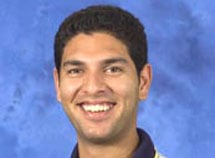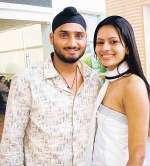Mona Sikh: Difference between revisions
No edit summary |
Allenwalla (talk | contribs) m (Lucky ji, i could not tell if the young Sardar had just taken Amrit and started growing a beard or was 'inhead' see discussion) |
||
| Line 1: | Line 1: | ||
[[Image:Yuveee.JPG|thumb|right|300px|Sardar | [[Image:Yuveee.JPG|thumb|right|300px|A young Sardar, trimmed hair, no Pag and no beard]] | ||
'''Mona Sardar''' | '''Mona Sardar''' is a term applied to a male of Sikh heritage who does not keep the basic kakkar of Kesh or untrimmed hair. As well as being labeled with the term Mona such men are often referred to as Rauda. | ||
[[Image:Bhajji1.jpg|thumb|right| | [[Image:Bhajji1.jpg|thumb|right|150px|Sardar who has just taken Amrit, his beard is just beginning to grow.]] | ||
According to the Sikh Rehat Maryada, the cuting of hair is a bujjer kurahit (the deed of an apostate - i.e. someone who has turned away from Sikhi). Today lakhs of sikhs are inhead (inhead is another perjoritive term similar to Mona and Rauda, used by Sikhs who are following the Rehat Maryada in reference to those who are not). | |||
Shortly before his death Guru Gobind Singh transferred spiritual authority for the Sikhs to the [[SGGS]] at the same time turning over matters of earthly conduct over to the Sikhs themselves. The Sikh [[Rehat Maryada]] is the product of collective Panthic wisdom. Some of the greatest Sikh scholars have contributed to and deliberated over its contents. It is a code of conduct which the Sikhs chosen authorities themselves have established. Actually the Rehat Maryada was proposed by the [[Shiromani Gurdwara Prabandhak Committee]]'s Conduct and Conventions Sub-Committee in 1936. It was reviewed again in January of 1945 with recommendations for certain additions to and deletions from it being proposed and considered. The following gentlemen attended this meeting of the Advisory Committee: | |||
:Singh Sahib Jathedar Mohan Singh, Jathedar Sri Akal Takhat; | |||
:Bhai Sahib Bhai Achhar Singh, Head Granthi, Sri Darbar Sahib, Amritsar; | |||
:Prof. Teja Singh M.A., Khalsa College, Amritsar; | |||
:Prof. Ganga Singh, Principal, Shahid Sikh Missionary College; | |||
:Giani Lal Singh, Professor, Sikh Missionary College, Amritsar; | |||
:Prof. Sher Singh M.Sc., Government College, Ludhiana; | |||
:Bawa Prem Singh of Hoti; | |||
:Giani Badal Singh, Incharge, Sikh Mission, Hapur. | |||
The code of conduct recieved final acceptance at the Shiromani Gurdwara Prabandhak's meeting held on 3rd Feb.,1945. | |||
Today the ideals of conduct decided by '''men''' in the first half of the last century are being questioned by the attitudes and actions of Sikhs in this modern and global age especially by the young. | |||
Around the world the Turban or 'Pag' is a recognized and respected symbol of Sikhi, but to really see the 'culture of the Turban' one must go to the Panjab where it is still prevalent, however, even there, many male Sikhs, especally the young have taken to trimming their beards which is not acceptable to the Rehat Maryada as framed in 1945. | |||
Revision as of 09:19, 23 July 2008
Mona Sardar is a term applied to a male of Sikh heritage who does not keep the basic kakkar of Kesh or untrimmed hair. As well as being labeled with the term Mona such men are often referred to as Rauda.
According to the Sikh Rehat Maryada, the cuting of hair is a bujjer kurahit (the deed of an apostate - i.e. someone who has turned away from Sikhi). Today lakhs of sikhs are inhead (inhead is another perjoritive term similar to Mona and Rauda, used by Sikhs who are following the Rehat Maryada in reference to those who are not).
Shortly before his death Guru Gobind Singh transferred spiritual authority for the Sikhs to the SGGS at the same time turning over matters of earthly conduct over to the Sikhs themselves. The Sikh Rehat Maryada is the product of collective Panthic wisdom. Some of the greatest Sikh scholars have contributed to and deliberated over its contents. It is a code of conduct which the Sikhs chosen authorities themselves have established. Actually the Rehat Maryada was proposed by the Shiromani Gurdwara Prabandhak Committee's Conduct and Conventions Sub-Committee in 1936. It was reviewed again in January of 1945 with recommendations for certain additions to and deletions from it being proposed and considered. The following gentlemen attended this meeting of the Advisory Committee:
- Singh Sahib Jathedar Mohan Singh, Jathedar Sri Akal Takhat;
- Bhai Sahib Bhai Achhar Singh, Head Granthi, Sri Darbar Sahib, Amritsar;
- Prof. Teja Singh M.A., Khalsa College, Amritsar;
- Prof. Ganga Singh, Principal, Shahid Sikh Missionary College;
- Giani Lal Singh, Professor, Sikh Missionary College, Amritsar;
- Prof. Sher Singh M.Sc., Government College, Ludhiana;
- Bawa Prem Singh of Hoti;
- Giani Badal Singh, Incharge, Sikh Mission, Hapur.
The code of conduct recieved final acceptance at the Shiromani Gurdwara Prabandhak's meeting held on 3rd Feb.,1945.
Today the ideals of conduct decided by men in the first half of the last century are being questioned by the attitudes and actions of Sikhs in this modern and global age especially by the young.
Around the world the Turban or 'Pag' is a recognized and respected symbol of Sikhi, but to really see the 'culture of the Turban' one must go to the Panjab where it is still prevalent, however, even there, many male Sikhs, especally the young have taken to trimming their beards which is not acceptable to the Rehat Maryada as framed in 1945.


